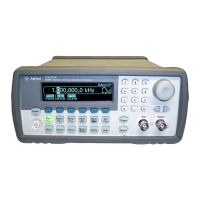206
Chapter 4 Remote Interface Reference
Phase Modulation (PM) Commands
4
PM:INTernal:FREQuency {<frequency>|MINimum|MAXimum}
PM:INTernal:FREQuency? [MINimum|MAXimum]
Set the frequency of the modulating waveform. Used only when the
Internal modulation source is selected (PM:SOUR INT command).
Select from 2 mHz to 20 kHz. The default is 10 Hz. MIN = 2 mHz.
MAX = 20 kHz. The :FREQ? query returns the internal modulating
frequency in hertz.
PM:DEViation {<deviation in degrees>|MINimum|MAXimum}
PM:DEViation? [MINimum|MAXimum]
Set the phase deviation in degrees. This value represents the peak
variation in phase of the modulated waveform from the carrier
waveform. Select any value from 0 to 360 degrees.
The default is 180
degrees
. MIN = 0 degrees. MAX = 360 degrees. The :DEV? query returns
the phase deviation in degrees.
•
If you select the
External
modulating source (
PM:SOUR EXT
command
),
the deviation is controlled by the ±5V signal level present on the rear-
panel Modulation In connector. For example, if you have set the
frequency deviation to 180 degrees, then a +5V signal level
corresponds to a 180 degree phase deviation. Lower external signal
levels produce less deviation, and negative signal levels produce a
negative phase shift.
PM:STATe {OFF|ON}
PM:STATe?
Disable or enable PM. To avoid multiple waveform changes, you can
enable PM after you have set up the other modulation parameters.
The default is OFF. The :STAT? query returns “0” (OFF) or “1” (ON).
• The function generator will allow only one modulation mode to be
enabled at a time. For example, you cannot enable PM and AM at the
same time. When you enable PM, the previous modulation mode is
turned off.
• The function generator will not allow PM to be enabled at the same
time that sweep or burst is enabled. When you enable PM, the sweep
or burst mode is turned off.

